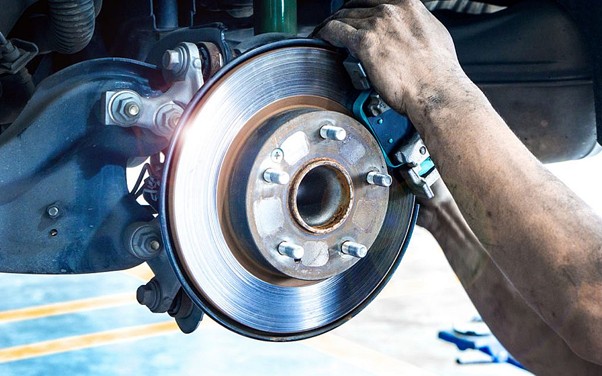“Brakes are the most important safety feature of any car; ignoring them can cost more than money.”
Did you know that nearly 70% of car accidents involve some type of brake failure? For Honda owners in Palmdale, CA, understanding the signs of brake issues can save both lives and money. From strange noises to a soft brake pedal, spotting problems early is key. This guide will help you identify and fix common brake issues so your Honda stays safe and reliable. If you live in Palmdale, California, Automotive Repair in Palmdale, CA can help ensure your vehicle remains safe and reliable.
1. Understanding Brake Wear and Tear
Brakes naturally wear down over time. The most common part that wears is the brake pad. A worn brake pad reduces stopping power and can damage other parts of your braking system. Look for thinning brake pads, which can sometimes be seen through the wheel spokes. If the pads are less than 3mm thick, it’s time to replace them.
Brake rotors also wear out. They can become warped due to heat from frequent braking. Warped rotors often cause vibrations in the steering wheel when braking. Regular inspections prevent minor issues from turning into costly repairs.
2. Unusual Noises Are a Warning
Strange sounds are one of the first signs of a problem. Common noises include:
- Squealing or screeching – often caused by worn brake pads or dust accumulation.
- Grinding – indicates metal-on-metal contact due to completely worn pads.
- Clicking or popping – can be from loose hardware or caliper issues.
Ignoring these sounds can damage your braking system. For Honda vehicles, these noises usually signal a need for immediate service to prevent rotor damage or brake failure.
3. Soft or Spongy Brake Pedal
If your brake pedal feels soft or goes to the floor, this points to potential issues:
- Air in brake lines – reduces hydraulic pressure, making braking less effective.
- Brake fluid leaks – fluid is essential for your system to function properly.
- Worn master cylinder – the core component that pushes brake fluid to your wheels.
Regular checks for fluid level and pedal feel help catch problems early. Bleeding the brakes can remove air and restore normal pedal firmness.
4. Car Pulls to One Side When Braking
A Honda that pulls to the left or right while braking could have:
- Uneven brake pad wear – one side may grip more than the other.
- Stuck caliper – prevents one wheel from braking properly.
- Warped rotors – create uneven braking force.
Addressing these issues prevents uneven tire wear and ensures smoother, safer stops. If left unchecked, pulling can compromise handling and stability.
5. Warning Lights Should Never Be Ignored
Your Honda’s dashboard has warning lights to alert you about brake issues. If the ABS (Anti-lock Braking System) light or brake warning light turns on, it indicates:
- Low brake fluid
- ABS sensor problem
- System malfunction
Immediate inspection by a professional prevents further damage and ensures the car remains road-safe.
6. Brake Fluid Maintenance
Brake fluid absorbs moisture over time, which can reduce braking efficiency. Old or contaminated fluid leads to corrosion in the system and soft brakes. Honda vehicles typically need a fluid change every 2 years or 30,000 miles. Checking fluid level and color regularly helps maintain brake performance.
7. DIY Brake Check Tips for Honda Owners
While professional service is best, simple checks at home can save headaches:
- Inspect brake pads through wheel openings.
- Check brake fluid level in the reservoir.
- Listen for unusual noises when braking.
- Feel for vibrations or pulling while braking.
Documenting these observations helps technicians quickly pinpoint problems during brake repair in Palmdale, CA.
8. When to Seek Professional Help
Some brake problems require expert attention:
- Grinding metal sounds
- Brake pedal sinks to the floor
- ABS or warning lights active
- Car pulling heavily to one side
Automotive repair in Palmdale, CA experts can replace worn pads, resurface or replace rotors, bleed the brake system, and ensure your Honda brakes are functioning perfectly.
The Final Thoughts:
Maintaining brakes is not just about performance but safety. Paying attention to wear, noises, pedal feel, and fluid levels ensures smooth stops and prevents expensive damage. Regular inspections and timely repairs by professionals specializing in brake repair in Palmdale, CA keep your Honda safe on every drive.
FAQs
1. How often should I inspect my Honda brakes?
Check brake pads and fluid at least every 6 months or before long trips.
2. Can I replace brake pads myself?
Yes, if you have experience, but professional service ensures proper installation and safety.
3. What causes brake squealing in Honda cars?
Squealing usually comes from worn pads or dust buildup on the pads and rotors.
4. How do I know if my rotors are warped?
Vibrations in the steering wheel or a pulsating brake pedal indicate warped rotors.
5. Is brake fluid replacement necessary if brakes feel fine?
Yes, old fluid can reduce braking efficiency even if the pedal feels normal.







